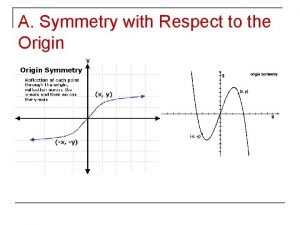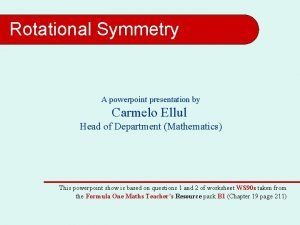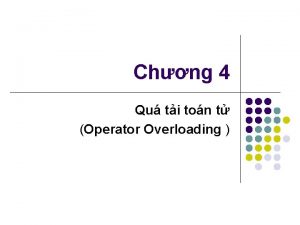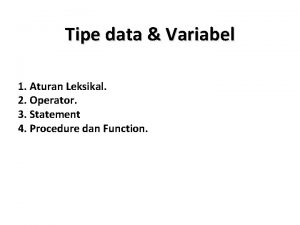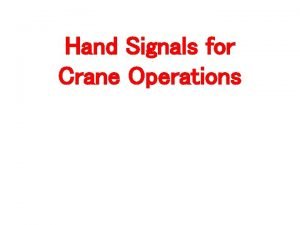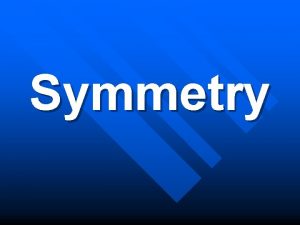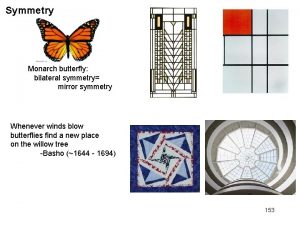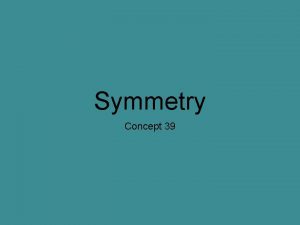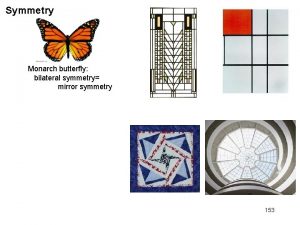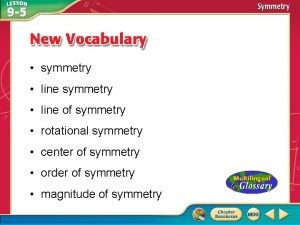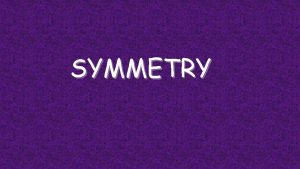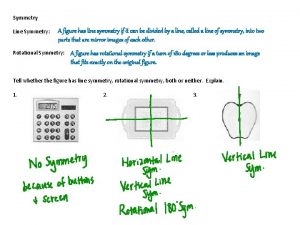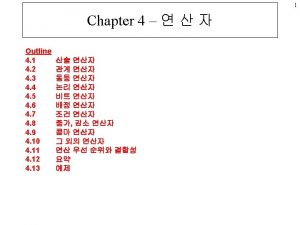Symmetry operator 2 Symmetry operator 4 x y

















- Slides: 17


Symmetry operator 2 -Symmetry operator 4 -x -y - ( ½+y ½-x -½-x-y -½+x-y ½+z ¼+z) ¼

Symmetry operator 2 -Symmetry operator 4 -x -y - ( ½+y ½-x -½-x-y -½+x-y ½+z ¼+z) ¼ Plug in u. u=-½-x-y 0. 18=-½-x-y 0. 68=-x-y Plug in v. v=-½+x-y 0. 22=-½+x-y 0. 72=x-y Add two equations and solve for y. 0. 68=-x-y +(0. 72= x-y) 1. 40=-2 y -0. 70=y Plug y into first equation and solve for x. 0. 68=-x-y 0. 68=-x-(-0. 70) 0. 02=x

Symmetry operator 2 -Symmetry operator 4 -x -y - ( ½+y ½-x -½-x-y -½+x-y ½+z ¼+z) ¼ Plug in u. u=-½-x-y 0. 18=-½-x-y 0. 68=-x-y Plug in v. v=-½+x-y 0. 22=-½+x-y 0. 72=x-y Add two equations and solve for y. 0. 68=-x-y +(0. 72= x-y) 1. 40=-2 y -0. 70=y Plug y into first equation and solve for x. 0. 68=-x-y 0. 68=-x-(-0. 70) 0. 02=x

Symmetry operator 2 -Symmetry operator 4 -x -y - ( ½+y ½-x -½-x-y -½+x-y ½+z ¼+z) ¼ Plug in u. u=-½-x-y 0. 18=-½-x-y 0. 68=-x-y Plug in v. v=-½+x-y 0. 22=-½+x-y 0. 72=x-y Add two equations and solve for y. 0. 68=-x-y +(0. 72= x-y) 1. 40=-2 y -0. 70=y Plug y into first equation and solve for x. 0. 68=-x-y 0. 68=-x-(-0. 70) 0. 02=x

Symmetry operator 2 -Symmetry operator 4 -x -y - ( ½+y ½-x -½-x-y -½+x-y ½+z ¼+z) ¼ Plug in u. u=-½-x-y 0. 18=-½-x-y 0. 68=-x-y Plug in v. v=-½+x-y 0. 22=-½+x-y 0. 72=x-y Add two equations and solve for y. 0. 68=-x-y +(0. 72= x-y) 1. 40=-2 y -0. 70=y Plug y into first equation and solve for x. 0. 68=-x-y 0. 68=-x-(-0. 70) 0. 02=x


Symmetry operator 3 -Symmetry operator 6 ½-y ½+x ¾+z - ( -y -x ½-z) ½ ½+2 x ¼+2 z Plug in v. v= ½+2 x 0. 48= ½+2 x -0. 02=2 x -0. 01=x Plug in w. w= ¼+2 z 0. 24= ¼+2 z -0. 01=2 z -0. 005=z

Symmetry operator 3 -Symmetry operator 6 ½-y ½+x ¾+z - ( -y -x ½-z) ½ ½+2 x ¼+2 z Plug in v. v= ½+2 x 0. 46= ½+2 x -0. 04=2 x -0. 02=x Plug in w. w= ¼+2 z 0. 24= ¼+2 z -0. 01=2 z -0. 005=z

Symmetry operator 3 -Symmetry operator 6 ½-y ½+x ¾+z - ( -y -x ½-z) ½ ½+2 x ¼+2 z Plug in v. v= ½+2 x 0. 46= ½+2 x -0. 04=2 x -0. 02=x Plug in w. w= ¼+2 z 0. 24= ¼+2 z -0. 01=2 z -0. 005=z

From step 3 Xstep 3= 0. 02 ystep 3=-0. 70 zstep 3=? . ? ? ? From step 4 Xstep 4=-0. 02 ystep 4= ? . ? ? zstep 4=-0. 005 Clearly, Xstep 3 does not equal Xstep 4. Use a Cheshire symmetry operator that transforms xstep 3= 0. 02 into xstep 4=- 0. 02. The x, y coordinate in step 3 describes one of the heavy atom For example, positions in thelet’s unit use: cell. The x, z coordinate in step 4 describes a -x, -y, copy. z symmetry related We can’t combine these coordinates And apply it todon’t all coordinates stepatom. 3. directly. They describe the in same Perhaps they even xreferred = - (+0. 02) to different origins. = -0. 02 step 3 -transformed ystep 3 -transformed = - (- 0. 70) = +0. 70 Now xstep 3 -transformed = xx, How can we transform y from step 3 so it describes step 4 And ystep 3 atom has been transformed to a reference the same as x and z in step 4? frame consistent with x and z from step 4. So we arrive at the following self-consistent x, y, z: Xstep 4=-0. 02, ystep 3 -transformed=0. 70, zstep 4=-0. 005 Or simply, x=-0. 02, y=0. 70, z=-0. 005

From step 3 Xstep 3= 0. 02 ystep 3=-0. 70 zstep 3=? . ? ? ? From step 4 Xstep 4=-0. 02 ystep 4= ? . ? ? zstep 4=-0. 005 Clearly, Xstep 3 does not equal Xstep 4. Use a Cheshire symmetry operator that transforms xstep 3= 0. 02 into xstep 4=- 0. 02. For example, let’s use: -x, -y, z And apply it to all coordinates in step 3. xstep 3 -transformed = - (+0. 02) = -0. 02 ystep 3 -transformed = - (- 0. 70) = +0. 70 Now xstep 3 -transformed = xstep 4 And ystep 3 has been transformed to a reference frame consistent with x and z from step 4. So we arrive at the following self-consistent x, y, z: Xstep 4=-0. 02, ystep 3 -transformed=0. 70, zstep 4=-0. 005 Or simply, x=-0. 02, y=0. 70, z=-0. 005 Cheshire Symmetry Operators for space group P 43212 X, -Y, Y, Y, -Y, X, -X, Y, Z -Y, Z X, 1/4+Z -X, 1/4+Z X, -Z -Y, 1/4 -Z 1/2+X, 1/2+Y, Z 1/2 -X, 1/2 -Y, Z 1/2 -Y, 1/2+X, 1/4+Z 1/2+Y, 1/2 -X, 1/4+Z 1/2+Y, 1/2+X, -Z 1/2 -Y, 1/2 -X, -Z 1/2+X, 1/2 -Y, 1/4 -Z 1/2 -X, 1/2+Y, 1/4 -Z X, -Y, Y, Y, -Y, X, -X, Y, 1/2+Z -Y, 1/2+Z X, 3/4+Z -X, 3/4+Z X, 1/2 -Z -Y, 3/4 -Z 1/2+X, 1/2+Y, 1/2+Z 1/2 -X, 1/2 -Y, 1/2+Z 1/2 -Y, 1/2+X, 3/4+Z 1/2+Y, 1/2 -X, 3/4+Z 1/2+Y, 1/2+X, 1/2 -Z 1/2 -Y, 1/2 -X, 1/2 -Z 1/2+X, 1/2 -Y, 3/4 -Z 1/2 -X, 1/2+Y, 3/4 -Z

From step 3 Xstep 3= 0. 02 ystep 3=-0. 70 zstep 3=? . ? ? ? From step 4 Xstep 4=-0. 02 ystep 4= ? . ? ? zstep 4=-0. 005 Clearly, Xstep 3 does not equal Xstep 4. Use a Cheshire symmetry operator that transforms xstep 3= 0. 02 into xstep 4=- 0. 02. For example, let’s use: -x, -y, z And apply it to all coordinates in step 3. xstep 3 -transformed = - (+0. 02) = -0. 02 ystep 3 -transformed = - (- 0. 70) = +0. 70 Now xstep 3 -transformed = xstep 4 And ystep 3 has been transformed to a reference frame consistent with x and z from step 4. So we arrive at the following self-consistent x, y, z: Xstep 4=-0. 02, ystep 3 -transformed=0. 70, zstep 4=-0. 005 Or simply, x=-0. 02, y=0. 70, z=-0. 005 Cheshire Symmetry Operators for space group P 43212 X, -Y, Y, Y, -Y, X, -X, Y, Z -Y, Z X, 1/4+Z -X, 1/4+Z X, -Z -Y, 1/4 -Z 1/2+X, 1/2+Y, Z 1/2 -X, 1/2 -Y, Z 1/2 -Y, 1/2+X, 1/4+Z 1/2+Y, 1/2 -X, 1/4+Z 1/2+Y, 1/2+X, -Z 1/2 -Y, 1/2 -X, -Z 1/2+X, 1/2 -Y, 1/4 -Z 1/2 -X, 1/2+Y, 1/4 -Z X, -Y, Y, Y, -Y, X, -X, Y, 1/2+Z -Y, 1/2+Z X, 3/4+Z -X, 3/4+Z X, 1/2 -Z -Y, 3/4 -Z 1/2+X, 1/2+Y, 1/2+Z 1/2 -X, 1/2 -Y, 1/2+Z 1/2 -Y, 1/2+X, 3/4+Z 1/2+Y, 1/2 -X, 3/4+Z 1/2+Y, 1/2+X, 1/2 -Z 1/2 -Y, 1/2 -X, 1/2 -Z 1/2+X, 1/2 -Y, 3/4 -Z 1/2 -X, 1/2+Y, 3/4 -Z

From step 3 Xstep 3= 0. 02 ystep 3=-0. 70 zstep 3=? . ? ? ? From step 4 Xstep 4=-0. 02 ystep 4= ? . ? ? zstep 4=-0. 005 Clearly, Xstep 3 does not equal Xstep 4. Use a Cheshire symmetry operator that transforms xstep 3= 0. 02 into xstep 4=- 0. 02. For example, let’s use: -x, -y, z And apply it to all coordinates in step 3. xstep 3 -transformed = - (+0. 02) = -0. 02 ystep 3 -transformed = - (- 0. 70) = +0. 70 Now xstep 3 -transformed = xstep 4 And ystep 3 has been transformed to a reference frame consistent with x and z from step 4. So we arrive at the following self-consistent x, y, z: Xstep 4=-0. 02, ystep 3 -transformed=0. 70, zstep 4=-0. 005 Or simply, x=-0. 02, y=0. 70, z=-0. 005 Cheshire Symmetry Operators for space group P 43212 X, -Y, Y, Y, -Y, X, -X, Y, Z -Y, Z X, 1/4+Z -X, 1/4+Z X, -Z -Y, 1/4 -Z 1/2+X, 1/2+Y, Z 1/2 -X, 1/2 -Y, Z 1/2 -Y, 1/2+X, 1/4+Z 1/2+Y, 1/2 -X, 1/4+Z 1/2+Y, 1/2+X, -Z 1/2 -Y, 1/2 -X, -Z 1/2+X, 1/2 -Y, 1/4 -Z 1/2 -X, 1/2+Y, 1/4 -Z X, -Y, Y, Y, -Y, X, -X, Y, 1/2+Z -Y, 1/2+Z X, 3/4+Z -X, 3/4+Z X, 1/2 -Z -Y, 3/4 -Z 1/2+X, 1/2+Y, 1/2+Z 1/2 -X, 1/2 -Y, 1/2+Z 1/2 -Y, 1/2+X, 3/4+Z 1/2+Y, 1/2 -X, 3/4+Z 1/2+Y, 1/2+X, 1/2 -Z 1/2 -Y, 1/2 -X, 1/2 -Z 1/2+X, 1/2 -Y, 3/4 -Z 1/2 -X, 1/2+Y, 3/4 -Z

Use x, y, z to predict the position of a non-Harker Patterson peak • x, y, z vs. –x, y, z ambiguity remains In other words x=-0. 02, y=0. 70, z=-0. 005 or x=+0. 02, y=0. 70, z=-0. 005 could be correct. • • Both satisfy the difference vector equations for Harker sections Only one is correct. 50/50 chance Predict the position of a non Harker peak. Use symop 1 -symop 5 Plug in x, y, z solve for u, v, w. Plug in –x, y, z solve for u, v, w I have a non-Harker peak at u=0. 28 v=0. 28, w=0. 0 The position of the non-Harker peak will be predicted by the correct heavy atom coordinate.

x y z symmetry operator 1 -symmetry operator 5 -( y x -z) u v w x-y -x+y 2 z First, plug in x=-0. 02, y=0. 70, z=-0. 005 u=x-y = -0. 02 -0. 70 =-0. 72 v=-x+y= +0. 02+0. 70= 0. 72 w=2 z=2*(-0. 005)=-0. 01 The numerical value of these coordinates falls outside the section we have drawn. Lets transform this uvw by Patterson symmetry v, -u, -w. -0. 72, -0. 01 becomes -0. 72, 0. 01 then add 1 to u and v 0. 28, 0. 01 This corresponds to the peak shown u=0. 28, v=0. 28, w=0. 01 Thus, x=-0. 02, y=0. 70, z=-0. 005 is correct. Hurray! We are finished! In the case that the above test failed, we would change the sign of x.

 Unary and binary operator
Unary and binary operator Pada tipe data boolean berlaku operator-operator adalah
Pada tipe data boolean berlaku operator-operator adalah Pada tipe data boolean, berlaku operator-operator
Pada tipe data boolean, berlaku operator-operator Prioritas operator
Prioritas operator If a graph is symmetric with respect to the origin
If a graph is symmetric with respect to the origin Order of rotational symmetry
Order of rotational symmetry T operator
T operator Symbol oprator logika “or” yaitu
Symbol oprator logika “or” yaitu Bagian dari program yang akan diabaikanoleh compiler adalah
Bagian dari program yang akan diabaikanoleh compiler adalah What is operator precedence and associativity
What is operator precedence and associativity Dog everything hand signal
Dog everything hand signal Tangent linear model
Tangent linear model Operator algoritma
Operator algoritma Where was buddhism located in 1500
Where was buddhism located in 1500 Berikut yang termasuk operator logika ingkaran adalah
Berikut yang termasuk operator logika ingkaran adalah Squeezing operator
Squeezing operator Perl assignment operators
Perl assignment operators Ectp certification
Ectp certification




